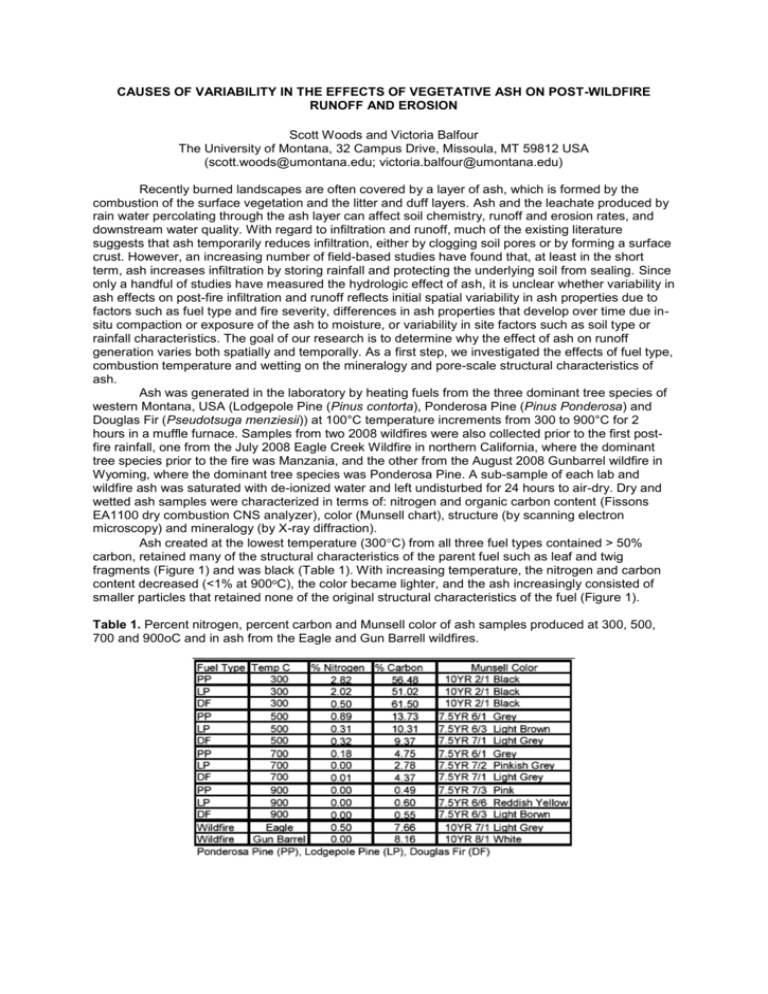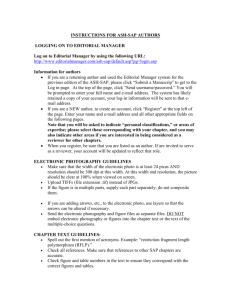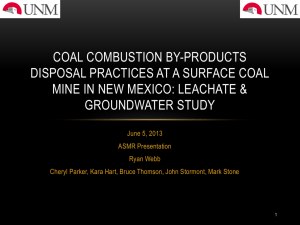causes of variability in the effects of vegetative ash on post
advertisement

CAUSES OF VARIABILITY IN THE EFFECTS OF VEGETATIVE ASH ON POST-WILDFIRE RUNOFF AND EROSION Scott Woods and Victoria Balfour The University of Montana, 32 Campus Drive, Missoula, MT 59812 USA (scott.woods@umontana.edu; victoria.balfour@umontana.edu) Recently burned landscapes are often covered by a layer of ash, which is formed by the combustion of the surface vegetation and the litter and duff layers. Ash and the leachate produced by rain water percolating through the ash layer can affect soil chemistry, runoff and erosion rates, and downstream water quality. With regard to infiltration and runoff, much of the existing literature suggests that ash temporarily reduces infiltration, either by clogging soil pores or by forming a surface crust. However, an increasing number of field-based studies have found that, at least in the short term, ash increases infiltration by storing rainfall and protecting the underlying soil from sealing. Since only a handful of studies have measured the hydrologic effect of ash, it is unclear whether variability in ash effects on post-fire infiltration and runoff reflects initial spatial variability in ash properties due to factors such as fuel type and fire severity, differences in ash properties that develop over time due insitu compaction or exposure of the ash to moisture, or variability in site factors such as soil type or rainfall characteristics. The goal of our research is to determine why the effect of ash on runoff generation varies both spatially and temporally. As a first step, we investigated the effects of fuel type, combustion temperature and wetting on the mineralogy and pore-scale structural characteristics of ash. Ash was generated in the laboratory by heating fuels from the three dominant tree species of western Montana, USA (Lodgepole Pine (Pinus contorta), Ponderosa Pine (Pinus Ponderosa) and Douglas Fir (Pseudotsuga menziesii)) at 100°C temperature increments from 300 to 900°C for 2 hours in a muffle furnace. Samples from two 2008 wildfires were also collected prior to the first postfire rainfall, one from the July 2008 Eagle Creek Wildfire in northern California, where the dominant tree species prior to the fire was Manzania, and the other from the August 2008 Gunbarrel wildfire in Wyoming, where the dominant tree species was Ponderosa Pine. A sub-sample of each lab and wildfire ash was saturated with de-ionized water and left undisturbed for 24 hours to air-dry. Dry and wetted ash samples were characterized in terms of: nitrogen and organic carbon content (Fissons EA1100 dry combustion CNS analyzer), color (Munsell chart), structure (by scanning electron microscopy) and mineralogy (by X-ray diffraction). Ash created at the lowest temperature (300C) from all three fuel types contained > 50% carbon, retained many of the structural characteristics of the parent fuel such as leaf and twig fragments (Figure 1) and was black (Table 1). With increasing temperature, the nitrogen and carbon content decreased (<1% at 900oC), the color became lighter, and the ash increasingly consisted of smaller particles that retained none of the original structural characteristics of the fuel (Figure 1). Table 1. Percent nitrogen, percent carbon and Munsell color of ash samples produced at 300, 500, 700 and 900oC and in ash from the Eagle and Gun Barrell wildfires. Figure 1. Micrographs of ash produced from Lodgepole pine fuel at 300 oC (left hand image) and 900oC (right hand image). Note the loss of the original fuel structural characteristics in the high temperature ash. Ash produced in the lab at 700 and 900oC regardless of fuel type, contained lime (CaO) whereas ash produced at temperatures of 300 and 500oC did not. When wetted, the lime in the high temperature ashes underwent a hydration-carbonation reaction that formed calcite (CaCO3). This calcite formed crusts within the ash structure that reduced the effective ash pore size (Figure 2). Lime was also present in both of the wildfire samples, and wetting resulted in a decrease in the lime content and recrystallization of the ash structure, similar to that noted in the higher temperature lab ashes. However, in contrast with the lab ash samples, the decrease in lime content was not accompanied by an increase in calcite, suggesting that wetting of these ash samples resulted in the formation of another mineral. Figure 2. Scanning electron microscopy images of 900oC ash samples before (left) and after (right) wetting. The image on the right shows calcite crust development and reduced pore size. Our results provide a potential explanation for the variability in ash effects on infiltration and runoff after wildfires. Ash produced in severe fires, when exposed to moisture, undergoes a similar hydration-carbonation reaction to that observed in our high temperature ash samples, resulting in the formation of a surface crust that impedes infiltration. The reaction does not occur in ashes produced under less severe fire conditions, so that the ash has less effect on infiltration. In our ongoing research we are evaluating the effects of differences in moisture availability on the wetting-related reactions, and differences among ashes in terms of hydrologic properties such as porosity, pore size distribution and hydraulic conductivity.








